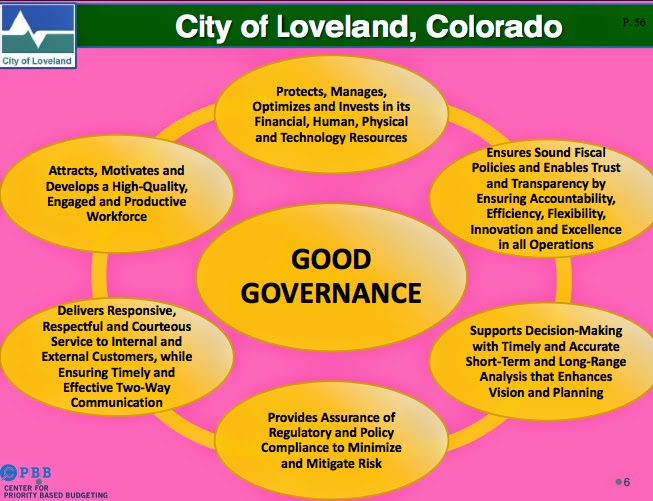"Never waste a good crisis" is often the battle cry heard before significant change can be ushered in. The City of Loveland SEES THINGS DIFFERENTLY by implementing PBB, not because of a crisis, but to proactively unleash valuable resources to avoid one." - CPBB Co-founder Chris Fabian
The Center for Priority Based Budgeting presented the final “Resource Alignment Diagnostic Tool” developed for the City of Loveland, CO based on its implementation of the Priority Based Budgeting process on May 13, 2014. This model reflects the completed scoring and costing data for each of the City’s programs. The model can sort the 800 programs provided by the City for both Community and Governing results into quartiles, showing which are most relevant towards achieving the goals based on the scoring process and the amount of funding that goes towards these highly relevant programs. See City of Loveland "Diagnostic Tool" overview (page 49).
BACKGROUND
In December, the City began the Priority Based Budgeting process guided by the Center for Priority Based Budgeting. In the first step, Council established the broad goals they wish City services to achieve. The second step involved staff, the Boards & Commissions and the public to define these goals. Simultaneously, staff developed a program inventory of all services offered and the costs associated with each program. The final step was for the departments to score their programs on each of the program's relevance to the goals. Peer Review Teams, drawn from middle management and Lead Loveland Alumni, reviewed the Department scores and adjusted the scores based on the team’s view of the program's relevance to the goal as a quality control measure.
The Center places this data into their model. The model has the flexibility to present many different
views or “sorts” of the programs for staff and Council to use as an aid in developing the 2015 Budget. The City will be able to keep the model for use in the future. With the completion of the model, we will have a tool to align service delivery and resources to better achieve the goals established by Council.
The presentation will focus on how the tool works, rather than on how specific programs scored. As staff and Council learn how to use the Diagnostic Tool, we will schedule a separate study in late June, for an in depth look at the program scoring and prioritization, differences in the peer review scoring from the department scoring and look to receive direction from Council on the 2015 Budget development at that time.
From a high level view of the results from the peer Review Process; in the Community Results programs, 160 programs moved at least one quartile in the peer review process, 65 programs were moved up one quartile, 71 programs we moved down one quartile and 24 programs were moved down two quartiles. In the Governing Results programs, 49 programs were moved by at least one quartile, 1 program was moved up by two quartiles, 2 programs moved up two quartiles, 43 programs moved down one quartile, and 3 programs moved down two quartiles.
REMARKABLE MOTIVES FOR PRIORITY BASED BUDGETING
Most profoundly, the City of Loveland implemented Priority Based Budgeting knowing that they weren’t facing a budget deficit. In other words, City Council insisted on a complete implementation of Priority Based Budgeting, including a robust citizen engagement initiative involving both town hall meetings and online citizen input, with the complete awareness that they didn’t have cuts to make, but instead new resources to allocate.
Why is this important?
From Council’s perspective, there were three primary objectives at the heart of their implementation:
- They wanted to ensure that for every “new” initiative or program proposed for approval, that the program was evaluated against the newly established PBB criteria, set by Council and citizens. No “new” programs will be initiated simply because there is new money to allocate; only “new” initiatives that also prove to be a high priority will deserve consideration.
- They wanted resource “re-allocation” options and opportunities to be identified clearly, which could provide resources to fund new programs, without necessarily allocating their increased revenue.
- Most importantly, they perceived their role in a way as stewards of the City’s resources towards the future. They recognized that unforeseen emergencies such as Colorado’s historic flooding of 2013 could easily put at risk the City’s solid Fiscal Health. They believed the continued fragility of the economy will continue to present uncertainty in the future. And looking back on tougher times in the City, this Council firmly concluded that they never wanted to be in a position to have to resort to “across-the-board” budget cuts ever again.
On all three counts, Priority Based Budgeting has helped Loveland achieve their objectives, when not a single one of their objectives was to cut the budget. This is remarkable, and we at CPBB couldn’t be more supportive of the City’s leadership and vision toward these ends!
Keep an eye on the CPBB blog for further updates. Sign-up for our social media pages so you stay connected with TEAM CPBB!
If you're thinking of jumping into the world of Fiscal Health and Wellness through Priority Based Budgeting we would certainly like to be part of your efforts! Contact us to schedule a free webinar and identify the best CPBB service option(s) to meet your organization's particular needs.
Register Now and Book Your Hotel!
New, Reduced Membership Dues
A new, reduced dues rate is available for CAOs/ACAOs, along with additional discounts for those in smaller communities, has been implemented. Learn more and be sure to join or renew today!





